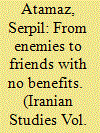| Srl | Item |
| 1 |
ID:
124961


|
|
|
|
|
| Publication |
2013.
|
| Summary/Abstract |
The centralization-decentralization controversy has been considered the key to understanding Second Ottoman constitutional politics. The Committee of Union and Progress (CUP) is considered to be centralist, while the opposition is regarded as decentralist under the intellectual influence of Prens Sabahattin with the support of non-Turkish ethnic groups. In actuality, both the CUP and the opposition emphasized the need for administrative decentralization (or the delegation of authority) while they rejected political decentralization, considering it as a first step toward the dismemberment of the Empire. Non-Turkish politicians shared this general state of mind as well. Therefore, the political bipolarization and its causes during this period needs to be reconsidered from a different viewpoint.
|
|
|
|
|
|
|
|
|
|
|
|
|
|
|
|
| 2 |
ID:
190110


|
|
|
|
|
| Summary/Abstract |
Freemasonic activity in the Ottoman lands saw an unprecedented growth and dynamism in the final phase of Ottoman history particularly benefitting from its close association with the Young Turk movement and its political apparatus, the Committee of Union and Progress (CUP). Ottoman freemasonry was led to a new level of popularity with a great deal of public visibility, a consequence of which was the formation of the Ottoman Grand Orient as a national organization for the first time in the Ottoman lands. Despite the ensuing controversial accusations and conspiracy theories against the freemasonic institution which became commonplace during the period in question, it occupied a place within the Ottoman state and society which it had never attained before. This made it possible for the Ottoman freemasons to integrate themselves to the universal fraternal discourse of the freemasonic philosophy during a last attempt of the Ottoman administration to keep its remaining lands intact. The intention of this article is to create a window within the broader picture of the socio-political environment of the time with a view to the position and involvement of freemasonry in which its association with the CUP often stands out as a major factor.
|
|
|
|
|
|
|
|
|
|
|
|
|
|
|
|
| 3 |
ID:
180024


|
|
|
|
|
| Summary/Abstract |
This paper examines the historical developments and the debates revolving around the formation of an Ottoman–Iranian alliance in the Ottoman Empire in the aftermath of the 1908 Revolution. It argues that although neither the idea of an alliance between the two states nor the attempt to establish it was new, the way it was discussed, justified, and promoted in this period was different. The previous attempts by the Ottomans were led by the state as part of a broader pan-Islamist project (ittihad-ı İslam) that adopted a heavily religious tone. On the other hand, the main proponents of the alliance during the constitutional period were mostly transnational/international figures and religious scholars, who framed the issue within the context of Ottoman–Iranian relations, focusing on immediate pragmatic, strategic, and ideological concerns, such as protecting the sovereignty and security of the two countries against European imperialism through constitutionalism. Rather than focusing on reconciling the disputes between the Sunnis and Shi’is, and presenting this alliance as the first step towards the formation of a broader Islamic union as Abdülhamid II did in the nineteenth century, these people emphasized brotherhood and solidarity between the two constitutional governments, and tried to establish a strategic partnership based on shared borders, experiences, ideals, and enemies.
|
|
|
|
|
|
|
|
|
|
|
|
|
|
|
|
| 4 |
ID:
153589


|
|
|
|
|
| Summary/Abstract |
Properties belonging to Ottoman Armenians and Greeks were seized through various laws, decrees and other legal regulations passed by the Committee of Union and Progress (hereafter CUP) government, and later the cadres of the Republican regime. Both governments concocted ways of making this illegal process look legitimate by using the legal veil of the law. Central to this process were the economic outcomes of violence committed against Armenians and Greeks. The aim of this article is to analyze these laws and statutes, which were known as the Abandoned Properties Laws, and discuss the impact of this legislation on the process of the changing of hands of Armenian and Greek properties. It attempts to elucidate the dominant logic of the laws, decrees, and regulations concerning the abandoned properties in the periods of 1915–1923 and post-1923.
|
|
|
|
|
|
|
|
|
|
|
|
|
|
|
|